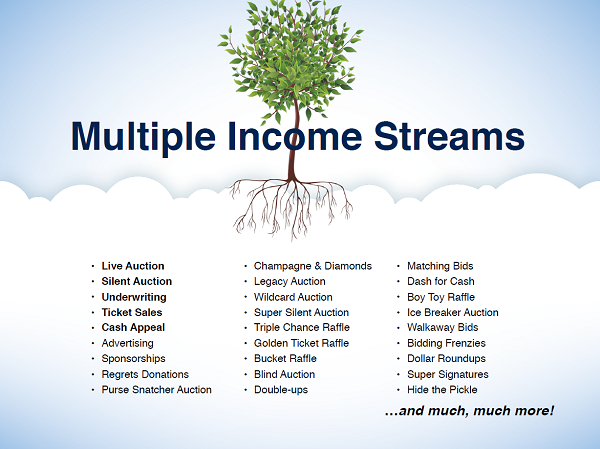 As the peak of summer winds down, fall fundraising season is fast approaching. That means it’s almost time for many nonprofits’ version of the “Super Bowl”: the annual charity gala, auction, raffle, tournament and more.
As the peak of summer winds down, fall fundraising season is fast approaching. That means it’s almost time for many nonprofits’ version of the “Super Bowl”: the annual charity gala, auction, raffle, tournament and more.
Imagine the doors are open, the ballroom is full, tickets have been sold, and the crowd is ready to support your cause—with bigger philanthropic wallets than anyone ever estimates. You’ve only got 4 or 5 hours to capture all that money for your cause before it walks out the room at the end of the night.
Time is not your friend, and you don’t want to waste any of it.
Where should the money come from during your fundraising event? Everyone knows the most popular income streams: the live auction, silent auction, cash appeals. In fact there are many different income streams to consider:
In this revenue-generating tree, the leaves represent the money you’re trying to raise for your cause. Each root and tendril represents a different potential income stream that could be pulled up during your charity fundraiser.
Bottom line: Profits don’t just happen.
To get all the leaves off the tree, organizations need to create a detailed, diverse profit plan now, months before the fundraising event, in the planning stages. And you need someone who knows what they’re doing at the helm of your event—someone who will use the right tools at the right time to raise as much as possible.
Read on for practical tips to incorporate diverse revenue generators into the night’s agenda, plus the answers to a few common questions we’ve received on the topic.
Cut fundraising “dead zones” out of your agenda
When planning the night’s agenda, think very critically of each element in the evening’s agenda. Is this producing income and getting us closer to our final fundraising goal?
This can be difficult for many nonprofits; after all, the annual gala has always had a lengthy entertainment portion, a 45-minute speech from the hospital administrator, the presentation of a dozen awards and the same trusty gift baskets and restaurant certificates in the silent auction.
That doesn’t mean you can’t do better. In fact, thinking outside the box, amping up excitement and streamlining the program will likely be a gamechanger for your event.
This is your Super Bowl, and it’s frustrating to see huge chunks of time dedicated to program “dead zones”: parts of the agenda that don’t generate a nickel of revenue.
Here’s a story from benefit auctioneer Danny Hooper that perfectly demonstrates the problem…
Once during a live auction, I was interrupted and auction shut down for 30 minutes so we could watch the event chair’s granddaughter tap dance. I don’t care how much you love tap dancing, half an hour from even the best child tapper is more than any person should have to endure. (Not to mention the crowd had paid $150 per ticket for a great night out!) Within minutes the crowd was out of control, I’d lost all the momentum, and that organization lost a lot of money.
There are many elements that can compose an entertaining evening, including speeches, videos, saying grace, singing the national anthem, having a special entertainer and more. But you need to keep the focus on the fundraising.
{{cta(‘b2b1ab00-6239-4fa8-880a-9f27eb952865′,’justifycenter’)}}
Take a critical eye to your speeches, at the venue, at the awards presentations. For elements of the evening that are important but typically don’t generate revenue, try to accomplish them in a fundraising capacity.
Could they set up a cash appeal, demonstrate the impact of your Fund-a-Need dollars, or create buzz for a live auction item?
Create your profit plan early
As mentioned, creating a workable profit plan happens not on the night of the event but months in advance. Incorporating different revenue generators into the agenda early allows you to get enough volunteers, bid card readers, materials and so forth to execute the plan. Plus, early preparation relieves the burden of stress that many event organizers face.
{{cta(‘f3bfc57a-4b5b-4a1f-ac62-9b87de2ca122′,’justifycenter’)}}
Be choosy
You don’t want to use too few income generators and leave money on the table. That said, with dozens of options on the tree and infinite possibilities yet to be thought up, no organization can use every income generator they think of in the agenda—and keep the night under 4 to 5 hours.
You’ll need to gather your auction and event committees and ask, “Which of these different income draw options are the right fit for our audience and for our event?” Figure out which money makers would be most applicable for your cause, and don’t be afraid to try something new.
Keep eyes peeled for new opportunities
Now that you’ve decided on the tools you’ll use to draw out revenue, be ready to improvise on event day! If a video or speech has an unexpected impact on the audience, for example, don’t be afraid to launch into a cash appeal. If a no-risk Winspire trip is igniting a bidding war among 3 or 4 guests, have your auctioneer stop bidding and sell multiples.
The amount of flexibility you’ll have depends on the size of the event, but with a benefit auctioneer as the “quarterback” of your Super Bowl, rest assured they will be able to spot and capitalize on the opportunities.
{{cta(‘bc4b315d-659b-4f3f-b7ab-190318c1f75a’,’justifycenter’)}}
Get more ideas in Checklist Builder
The revenue generating tree is just a sampling of all the possibilities there are at your disposal. Income streams at events don’t have to be limited to auctions, underwriters and ticket sales. You have so many tools that you can use to drive up revenue and increase fundraising profits.
Information on these different revenue streams, including ones you may not have considered previously or even heard of, are described in detail in our latest resource, Checklist Builder. Sign up free and instantly have access to 4 of the most important fundraising event production committees, which contain plenty of free sample event forms and templates to save hours of time.
{{cta(‘ba326600-0d41-427d-9835-342fbadae3ec’,’justifycenter’)}}
If you like what you see, upgrade to an annual paid subscription for just $99 and get instant access to auction ideas in the “Silent & Live Auction” committee. These ideas include instructions for a wine tree auction, sealed bid silent auction, triple-chance raffle, Wildcard auction and more!
Q&A from Real Fundraisers!
Q: What is the average number of income streams, and how many is too many?
A: It depends on the size of your event and how many hours you have to work with. A typical small-to-medium sized auction can easily fit 6 or 8 different income streams: think a live auction, silent auction, super silent auction, raffles, a wildcard auction, cash appeals, and a fun one like a purse snatcher or “hidden pickle” auction (find out more about this in Checklist Builder!).
That said, we have seen events incorporate 20 different income producing activities in the evening, and they run like Swiss clocks and end right on time.

How do these nonprofits pull it off? First, they typically have an event chair with expertise who knows how to fine-tune everything in the evening. Every portion of the event is properly planned for and well executed. Guests use bid cards throughout the evening, which keeps everything moving and organized. Long, boring sections of the night are eliminated.
Best of all, successful organizations understand balance: They focus on the fundraising without getting to the point where guests felt nickeled and dimed.
Q: Our event ticket prices are quite high. Would you still recommend 6 to 8 revenue streams? Do you consider ticket sales one of those streams?
Yes, we’d absolutely still recommend multiple revenue streams. The reason being, revenue streams are entertaining! Entertainment is one of the 3 basic tenets of a successful fundraising event.
Wildcard auctions, for example, are entertaining and enjoyable. A Super Silent Auction is a great way to use premium items that could have been in your live auction but are used elsewhere to respect guests’ time.
{{cta(‘6dd5b157-115c-469a-b913-7f73a5a29f55′,’justifycenter’)}}
About the number of income streams: There’s no magic or fixed number. The answers to specific questions while you’re planning the agenda should come from your auctioneer. They should also provide free consulting service to you, so don’t be afraid to ask her or him questions. They’ve had extensive event fundraising experience and will take a microscopic look at the peculiarities of your individual event.
Q: Is entertainment always a waste of time? We are a ballet school, and we have a 15-minute performance scheduled during dinner.
 A: Not at all. What generates revenue depends on your organization, and as a ballet school, it certainly sounds like an appropriate use of your time to demonstrate the impact of your donors’ support by holding a ballet performance. In these cases it’s also a good opportunity to transition that right into a cash appeal or fund a need.
A: Not at all. What generates revenue depends on your organization, and as a ballet school, it certainly sounds like an appropriate use of your time to demonstrate the impact of your donors’ support by holding a ballet performance. In these cases it’s also a good opportunity to transition that right into a cash appeal or fund a need.
The takeaway: As long as an activity has an income producing objective at its core, you’re on the right track.
And for organizations that aren’t a dance school, from our experience we have found you don’t always need entertainment like music or dancing. A professional benefit auctioneer will more than likely provide all of the entertainment for the evening.
{{cta(‘9e1496f0-d62f-4f98-ada2-9aef1af93ccb’,’justifycenter’)}}
The live auction is actually the place where most of the entertainment should be happening.

